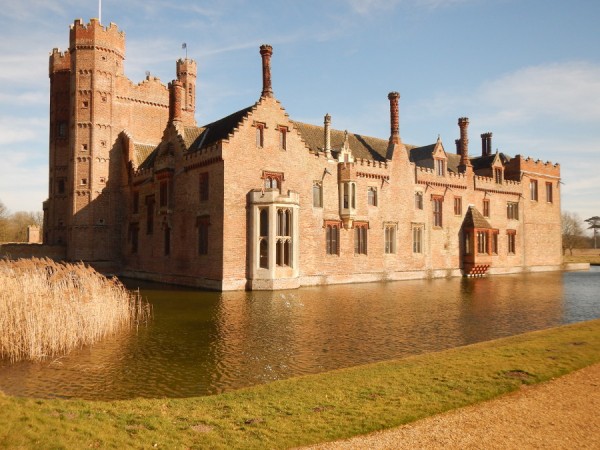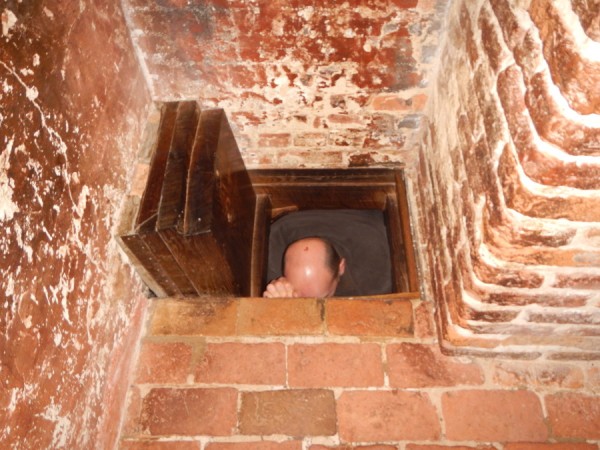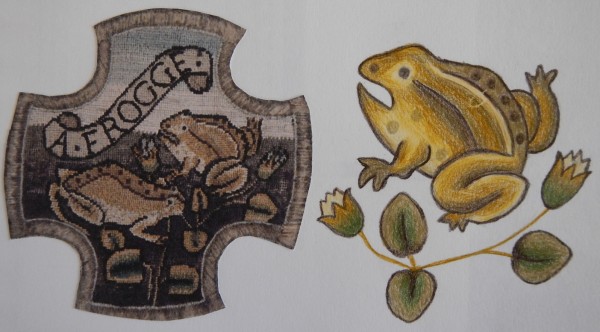I have finally been to see the Marian Hangings at Oxburgh Hall in Norfolk. I’ve wanted to see them for a long time, as they’re such an important part of English embroidery history. They are a collection of canvas-work panels stitched by Mary Queen of Scots during her years of captivity. They are based on contemporary drawings from natural history books; some are wierd and wonderful creatures that are part real and part mythical, and others are recognisable creatures. I like this one, A Frogge, (that’s my pencil drawing of him next to it). The main motifs were probably originally stitched as individual items such as cushion covers, and were later placed together onto huge velvet backing panels. The techniques involved are quite restricted, but the painstaking work is amazing. 
Oxburgh Hall is a beautiful place. As we wandered round in the spring sunshine, eating National Trust cakes and taking photos, it was is hard to picture it as a place of captivity. There is no doubt that Mary used embroidery as a subtle form of political expression. Historians debate how far the imagery should be taken as allegorical. For example one piece shows a lily on one side (symbolising France) and a rose on the other side (symbolising England.) A thistle, representing Scotland, lies on its side at the bottom of the picture, looking squashed and lacking space to grow freely. Another bears the motto ‘Virtue flourishes by wounding’ together with the thistle of Scotland. This was probably about as politically overt as Mary could be given the vulnerability of her position. It is hard to imagine the hours and hours, days and days, weeks and weeks, years and years, when Mary just waited. Waited, and embroidered. How amazing to think that she had the weight of history on her shoulders while she sat and stitched. If she could be a fly on the wall now, how bizarre it would be to see her work studied by earnest National Trust ladies in sensible shoes, peering at the stitches and then heading off to the tea-shop. Who remembers ‘Fotheringhay’, that haunting 70’s song by Fairport Convention, written about the later period when Mary was moved to Fotheringhay Castle waiting for execution ‘To live such fruitless years behind a guarded door’.
How often she has gazed from castle windows over
And watched the daylight passing within her captive wall
With no-one to heed her call
The evening hour is fading within the dwindling sun
And in a lonely moment those embers will be gone
And the last of all the young birds flown
Her days of precious freedom, forfeited long before
To live such fruitless years behind a guarded door
But those days will last no more
Tomorrow at this hour she will be far away
Much farther than these islands
Or the lonely Fotheringay
I must just show you this photo of the priest-hole in Oxburgh Hall, the hiding-place for Catholic priests who were being hunted down and were hidden in big Catholic houses. That’s my brother going down into it (yes he did get out again – he was a caver for many years!) 
Sadly the reason for being in Norfolk was the funeral of a very long-standing friend of my mother’s, who became an ‘Honorary Auntie’ for the three Robinson siblings. Rosemary was always there for words of wisdom and advice, combined with marvellous head-girl cheerfulness that defied anyone to be negative. The funeral was held in the beautiful Church in Worsted village in Norfolk. Rosemary left only one specific instruction for her funeral, which was that it was to open with the congregation singing ‘She’ll be coming round the mountain when she comes’! I defy anyone to be solemn and mournful whilst singing ‘She’ll be wearing pink pyjamas when she comes’! I think the whole congregation was crying and laughing at the same time. Rosemary used to end her phone calls or visits by wishing us ‘Much Cherish’. So here’s wishing you all ‘Much Cherish’.










